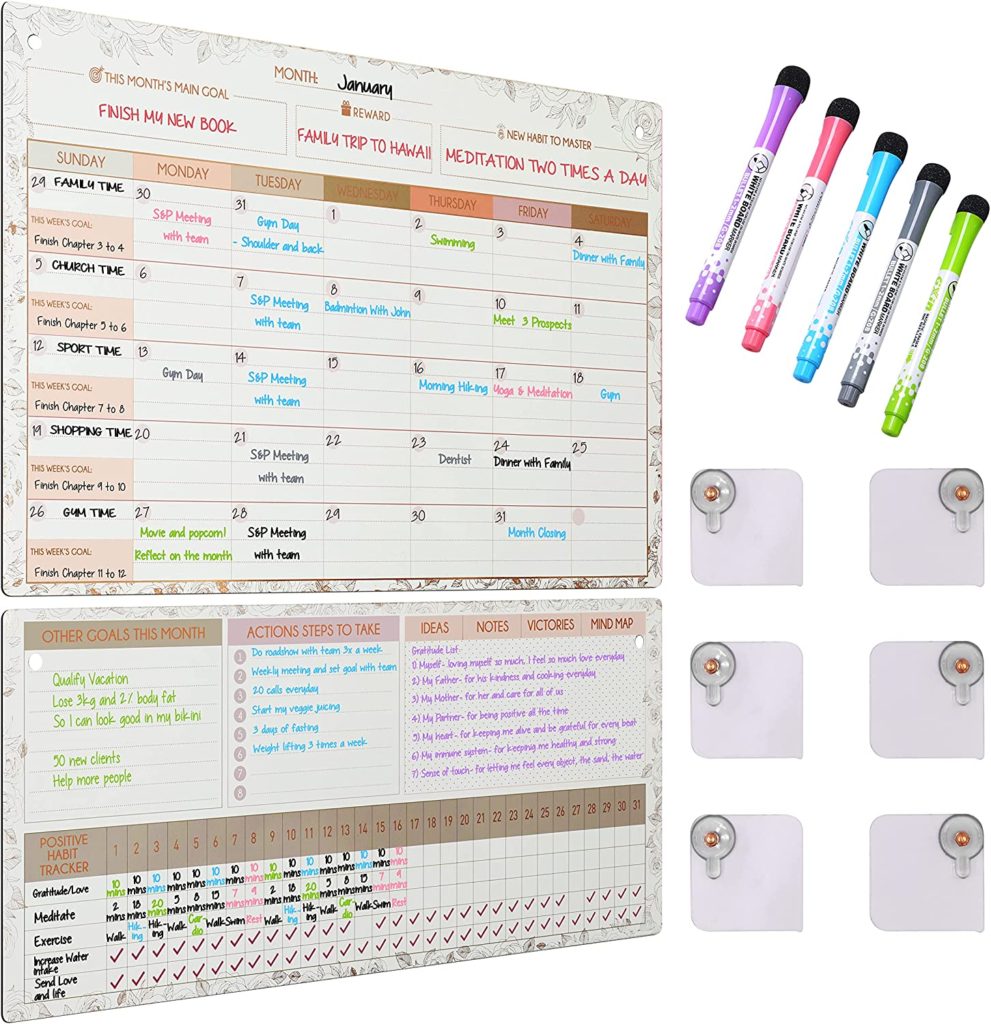Before starting organized family life, please write a plan for what it looks like for your family. There is a saying that goes something like this before building something; you must create the blueprint first. Therefore, before starting the first steps to an organized family life, start with the blueprint and vision of what you want to see in your family. What are your goals or ideas? What is your ideal vision for your family’s organization? Is it your house organization or your family’s schedule? Is it to cut clutter or ensure everyone is where they need to be on time? So before putting together the framework, start with the blueprint of your organized family life.
Once you have captured a vision of your organized family life, start including the following steps to make that vision a reality. When it comes to family organization, there are two things to consider one is family schedules and planning, and the other is house cleaning and decluttering. The first part of this article will focus on family schedules and organizing family tasks, and the final piece will focus on decluttering or cleaning.
To get your family schedules more on track, this is where you should start first:
- Hold a family meeting: Set aside time to have a family meeting to discuss household tasks, schedules, and any issues or concerns that need to be addressed.
- A family meeting is a scheduled gathering of family members to discuss critical issues, make decisions, or catch up with each other. Family meetings can improve communication, resolve conflicts, and strengthen family relationships.
- In a family meeting, whether over dinner, breakfast, or any other time, you should discuss the weekly schedules, plans, and desires for the week. This planning meeting can include tasks you need to complete, chores that need to get done, meals that your husband or your children would like to have, budgets, and any other conversations that need to happen that affect the whole family.
- Here are some tips on organizing family meetings:
- Set a schedule: Set up a regular time for family meetings, such as once a week or monthly. This helps ensure that everyone can plan around the meeting and prioritize attendance.
- Create an agenda: Prepare a plan to ensure the meeting stays on track and covers all essential topics. Encourage family members to contribute to the schedule to ensure everyone’s concerns and ideas are heard.
- Create a positive environment: Make sure the meeting space is comfortable and free of distractions. Encourage open communication and active listening to ensure everyone feels heard and valued.
- Follow through: Follow through on any decisions or action items agreed upon during the meeting. This helps to build trust and ensure that everyone takes the meeting seriously.
- After a family meeting, you can now break down the rest of your needs from the family meeting, such as meal planning, chore lists, schedules, and more.
- Next, create a schedule: using the information you have gathered from the family meeting, put together a plan that includes important dates, events, and appointments for each family member. This will help you keep track of everyone’s activities and avoid conflicts.
- Consider using a shared calendar so multiple people can access and edit as needed. Shared calendars can be helpful for families, as they allow everyone to see each other’s schedules and plan accordingly.
- Some benefits of using a shared calendar include the following:
- Improved organization: A shared calendar can help keep everyone in the family organized and on the same page. Having all critical dates and events in one place makes it easier to avoid scheduling conflicts and ensures everyone is aware of upcoming events.
- Increased communication: Sharing a calendar can help facilitate communication between family members. For example, if a child has a doctor’s appointment, they can add it to the calendar, and other family members can see it and plan accordingly.
- Reduced stress: A shared calendar can help reduce stress by cutting the need for last-minute schedule changes or surprises.
- Shared calendars can be physical or electronic. There are many different apps and tools available that can help you create and manage a shared calendar. Some popular options include Google Calendar, Apple Calendar, and Cozi. When setting up a shared calendar, it is essential to establish some ground rules to ensure everyone knows how to use it effectively. For example, set up guidelines about how far in advance events should be added to the calendar or how to handle scheduling conflicts.
- Plan out your meals: meal planning can be as simple as just writing down everyone’s ideas for the week on what they would like to eat, creating meal cards, or writing out an entire meal menu to keep out for others to see or using meal planning apps.
- I, for one, write down meal plan ideas and use phone apps. Meal planning apps help you plan, organize, prepare your meals, and keep everything in one place. These apps can be a valuable tool for families, as they can save time, reduce food waste, and help ensure everyone is eating healthy and balanced meals.
- Some benefits of using a meal-planning app include:
- Simplified meal planning: Meal planning apps can make it easy to plan your meals for the week ahead. Many apps offer pre-made meal plans or recipe suggestions, which can save time and reduce decision fatigue.
- Reduced food waste: By planning your meals, you can reduce the amount of food that goes into the trash. Meal planning apps can help you use ingredients you already have on hand and help you avoid buying too much food at the grocery store.
- Improved nutrition: Meal planning apps can help ensure you and your family eat healthy and balanced meals. Many apps offer recipe suggestions tailored to your dietary preferences and needs.
- Simplified grocery shopping: Many meal planning apps offer integrated grocery lists, which can save time and reduce stress when it comes to grocery shopping.
- Many different meal-planning apps are available, each with unique features and benefits. Some popular options include Mealime, Paprika Recipe Manager, and Plan to Eat. When selecting a meal-planning app, it is essential to consider your specific needs and preferences, as well as the needs and preferences of your family members.
- Finally, create routines: Setting up routines for meals, homework, and bedtime can help your family members stay on track, reduce stress, and help you get everything you wrote down in your family meeting to flow smoothly and efficiently.
- Establishing routines is an essential aspect of organizing your family life. Patterns can be beneficial for many reasons:
- Reduced stress: When you set up routines, you and your family know what to expect and when to expect it. This can reduce stress and anxiety, as everyone knows what needs to be done and when.
- Increased productivity: Routines can help you and your family be more productive and efficient. By setting up a regular schedule for homework, household chores, and meal preparation, you can avoid procrastination and ensure everything gets done promptly.
- Improved organization: Routines can help you organize your home and life. For example, by setting up a routine for cleaning and decluttering, you can keep your home tidy and free of clutter.
- When setting up routines, it’s essential to consider the needs and preferences of each family member. As your family’s needs change, you may need to adjust practices over time. Some tips for setting up rules include:
- Start small: Show routines for critical tasks, such as mealtimes or bedtime. Once these routines are set up, you can add more. This is especially useful when you have toddlers or small children. Starting with little things like putting away a chair or brushing their teeth every morning helps them to understand the value of the routine in the home.
- Be consistent: Stick to the routine as much as possible, even on weekends and holidays. Regarding nap time and bedtime, our toddler knows that she needs to be down for her nap at 12:30 and in bed for the night at 7:30. We have established a routine and were consistent with getting her in bed at that time. Now she is even teaching the babysitters that she needs to be in her crib at these times due to the consistency that was set up early on.
- Involve your family: Ask for input from your family members and involve them in establishing routines. This can help everyone feel invested and motivated to stick to the patterns.
- Be flexible: As with anything, flexibility is vital. While routines are essential, it’s also important to be flexible when necessary. Life can be unpredictable, and there may be times when you need to adjust your routines to accommodate unexpected events or changes.
- Establishing routines is an essential aspect of organizing your family life. Patterns can be beneficial for many reasons:








The other part of organized family life is house cleaning and decluttering. To achieve an organized life as a family, one understands that a clean and decluttered home also helps keep everything in its place and helps minimize stress and increase productivity.
The steps to organizing house cleaning and decluttering start with the following:
- Assigning age-appropriate chores to each family member can help distribute the workload, teach responsibility, and get everyone on board with cleaning and upkeeping the living space.
- Declutter: Go through your home and remove items that are no longer useful or needed. This can help create a more organized and peaceful living space.
- Teaching the family to upkeep the chores and return things to the assigned spaces using items like a command center or chore list to help spark a reminder and inspire self-responsibilities for supporting a peaceful home.
- Finally, like scheduling, you need to create a routine so that chores are completed routinely and become an automatic part of your family’s life.

Remember that organizing your family life is an ongoing process, and developing new habits and routines takes time. As with anything, good things are not always easy to implement, so give yourself grace and work on one thing at a time. In other words, only bite off what you can chew, start small, and build on your successes over time. Busy mom life can be hectic, so getting some organization into your life will help you maintain a more peaceful and organized home and life.
